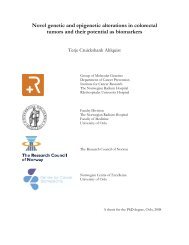Preface - Ous-research.no
Preface - Ous-research.no
Preface - Ous-research.no
You also want an ePaper? Increase the reach of your titles
YUMPU automatically turns print PDFs into web optimized ePapers that Google loves.
Plastic and reconstructive surgery<br />
3. Microcirculation and wound healing:<br />
To resemble a clinical situation, we are using animals with<br />
skin structure and function similar to the human skin. Pig<br />
skin has many similarities to human skin, including histological<br />
appearance and wound healing ability. We are using<br />
Norwegian pigs (Norsk landsvin) with weight between 25<br />
and 30 kg in our studies. Microcirculation and histological<br />
measurements are performed to evaluate the effect of different<br />
reconstructive procedures or other interventions on<br />
wound healing. To investigate microcirculation and wound<br />
healing in an isolated setting, we use rat models as described<br />
below.<br />
4. Experimental perforator flaps and other rat models<br />
Dissection of the perforator flaps preserves the muscle<br />
and minimizes the do<strong>no</strong>r site morbidity. Nevertheless,<br />
the method may have undesirable effects on the muscle<br />
because of damage of its innervation, blood supply or by<br />
direct injury when dissecting the perforator. This damage<br />
can be reduced by including a minimum number of perforators.<br />
However, a reduced number of perforators may<br />
be detrimental to the flap viability and wound strength.<br />
To study the effect of different numbers of perforators in a<br />
lipocutaneous flap we are using Wistar rats where two symmetrical<br />
abdominal lipocutaneous flaps are raised around<br />
the midline. On one side all major perforators of the flap are<br />
left intact and on the other side only the largest perforator is<br />
retained within the flap. After dissection, the flaps are fixed<br />
to the original position by a continuous suture. Microcirculation,<br />
flap viability, wound strength and histological changes<br />
are measured preoperatively and during the first week after<br />
the operation.<br />
To continue improvements in both a clinical and scientific<br />
setting <strong>research</strong> using animal models is important. The<br />
groin flap based on the superficial inferior epigastric artery<br />
(SIEA) is well described. However, as shown in our previous<br />
<strong>research</strong> there are problems with autocannibalism. In addition,<br />
postoperative flap monitoring is difficult when the flap<br />
is translocated to the abdominal side of the animal. Some<br />
studies have addressed these problems by transferring the<br />
flap to the dorsum of the rat. However, in these experiments<br />
the femoral vessels were ligated, with danger of an ischemic<br />
limb and possible tissue necrosis. The ischemic tissue may<br />
release factors that affect the microcirculation of the free<br />
flap. We have established a new SIEA flap model in the rat<br />
with good conditions for flap monitoring, without danger of<br />
flap autocannibalisation and with preserved limb circulation<br />
(fig 2). This model is used when performing studies on<br />
microcirculation and histological changes where we want<br />
to compare different interventions on the flap or the animal<br />
over a longer period of time.<br />
5. Microcirculation and reinnervation in human perforator<br />
flaps.<br />
The deep inferior epigastric artery perforator (DIEAP) flap<br />
from the abdomen is one of the most suitable perforator<br />
flaps used for breast reconstruction (fig 3 and 4). This<br />
procedure has had a significant impact on the field of plastic<br />
and reconstructive surgery, because of the high number of<br />
women requiring breast reconstruction after cancer surgery.<br />
Based on the experimental <strong>research</strong> and clinical experi-<br />
Figure 3. The abdominal flap is transposed to the thorax and is<br />
ready for revascularization.<br />
Figure 2. Dissection of the groin flap (left). Transposistion of the<br />
flap to the dorsum of the rat (right)<br />
Figure 4. Preoperative markings on the patient (left), and after<br />
breast reconstruction with DEIAP flap (right).<br />
48
















